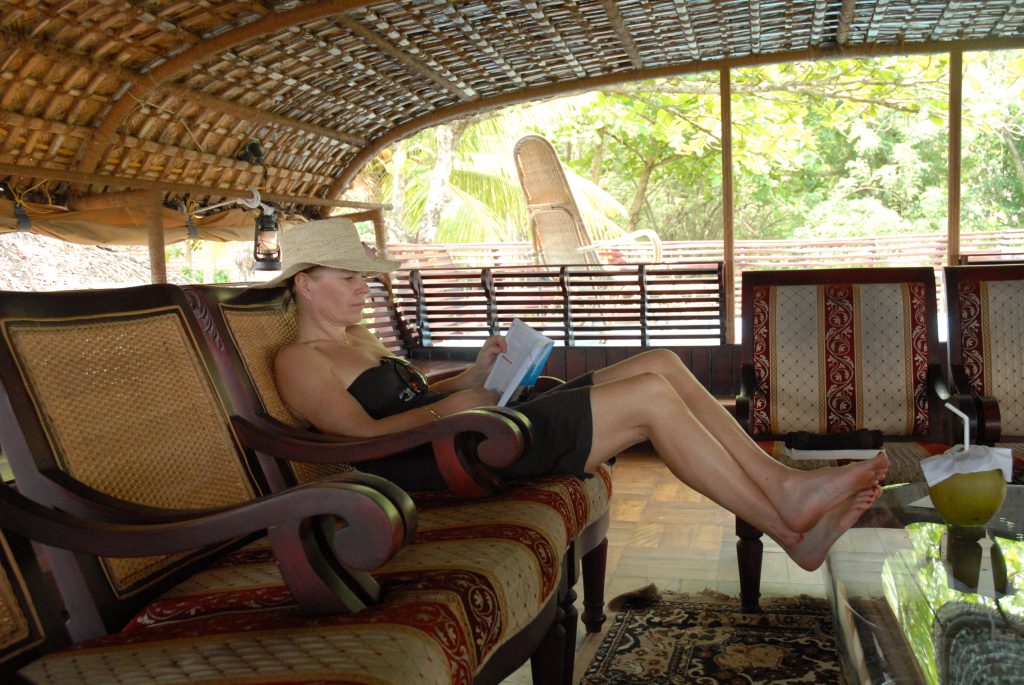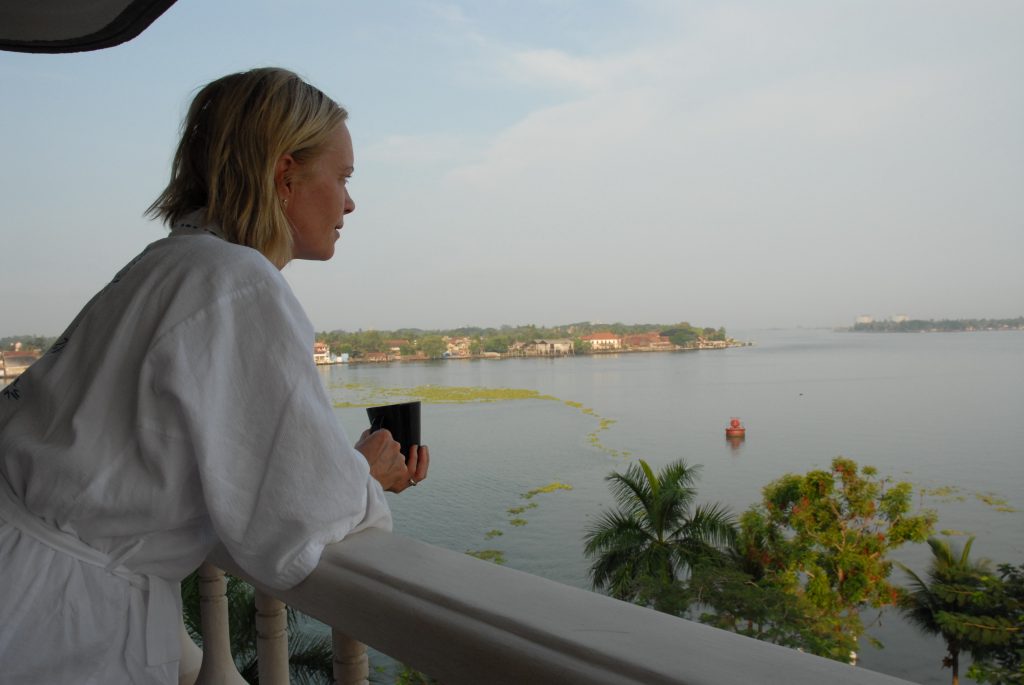When Salman Rushdie’s lovers made out on the spice sacks of a Cochin warehouse in The Moor’s Last Sigh I too was seduced. Nevertheless it’s taken all of 20 years to finally consummate the love affair. Now as I wander those same streets of Mattancherry in the port of Old Cochin they seem both familiar and totally exotic. Once the epicentre of Malabar’s spice trade, the scent of cardamom and pepper still lies heavy in the air; the jackfruits piled by the street vendors stalls, the rickshaw drivers chatter and the sprawling red roofed warehouses and cheerful palette of pastel houses came straight from Rushdie’s pages but the sense of being somewhere truly foreign is just as impactive.
Since I lost myself in the pages of that wonderful story so much of my favourite fiction has poured from India in a dazzling array of locations as varied and colourful as the tales set in them. From Rushdie’s intoxicating Cochin to Arundati Roy’s Keralan backwaters, the contemporary whirlpool of Delhi in White Tiger and the mighty Himalaya’s of Kiran Desai’s The Inheritance of Loss, there appeared no end to the imaginative scope and inventive fiction flowing from the sub continent and its immigrants. Yet despite the thousands of pages I’d read, taking my first steps there, on the fecund red soil of Kerala proved an equally sensory assault.
In the hazy fog following an all night flight, travelling through the interminable sprawl of Cochin’s outskirts, I was shocked by the garbage, the heat and the terrifying array of run down vehicles travelling at speeds that belied their exterior decrepitude. Our destination, Vivanta at Taj Kochi occupies what was once Cochin’s customs house and it certainly deserves an entry in the great river-view hotels of the world, facing out to the giant cranes of the shipbuilding yards and the Chinese fishing nets of Fort Cochin. We recuperated from our journey with a massage at their Jiva Spa that both of us snored through so it must have been good, an exhibition of Indian dancing that transfixed the kids and a meal spent watching the big ships come and go.
Next day, the unalluring sprawl of the suburbs was swiftly forgotten as we wandered the narrow shop and cafe lined cobbled streets of the old port. Antiques, large and small, including a ceremonial cooking pot or Vahtu that could have fed Akbar’s entire army jostled for space between the fabrics, textiles and cottons clamouring for our attention. The ancient trading history of this one time maritime hotspot, born in the 16th century and spanning Portuguese, Dutch and British Colonial rule was omnipresent in the peeling architecture and sprawling red roofed warehouses so vividly brought to life in Rushdie’s novel. While husband and son (5) sought out ceremonial daggers Molly (6), and I picked up a pint sized turquoise peasant skirt resplendent with mirrored discs that she didn’t remove for the entire vacation.
Setting out next day for the five-hour drive to the Tiger Sanctuary of Periyar or Thekeddy, as it’s locally known, we were introduced to Keralan road etiquette. Hogging neither left, nor right hand side of the road, you hurtle down the dead centre of any given byway, hand on horn, only diverting from oncoming traffic doing the same when you’re seconds from death. After our kamikaze ride I would have been happy to arrive alive in Milton Keynes let alone the haunting, melancholic majesty of Periyar. Far from the hustle and bustle of city life with it’s over powering scents and stenches it was blessedly cool, moist and utterly magical. We may not have spotted any of the 37 tigers left in this protected 777 square kilometres of the Cardamom Hills but we could sense their prowling presence as we boated across the mystical , tree stump scarred waters of the artificial lake that lies at the heart of the park to reach the government run Lake Palace. Two nights in this eccentrically located, charmingly staffed hotel, once the summer palace of the last Maharajah of Tamil Nardu and now crying out for a makeover, proved a gourmet delight and the perfect base for an elephant ride and spice plantation visit. We also discovered an interesting adaptation of the alarm call protocol. We would order a wake up with coffee for 7am and a gentleman would arrive at our door, solemnly announcing 7am, at any point between 6.30 and 7.45.
As you’ll have gathered I’m not expecting prizes for my backpacking bravado during these ten days in Kerala. With two kids under 7 in tow the road less travelled, if indeed it still exists in this well trammelled province, wasn’t really an option. We’d forsworn such exotic adventures when our kids were born but an unavoidable trip to Mozambique last year revealed our then 4 and 5 year olds to be intrepid travellers, perfectly happy with swallowing malaria pills, if slightly less excited by vaccinations. The former has according to the Keralan government been eradicated, the truth being that it is extremely rare but still possible to pick up here.
After two days in the mystical confines of the game reserve, hampered slightly by their ban on children under 12 taking walking safaris we headed back to the lowlands. For a literature lover it couldn’t have been a more enticing spot, the ‘History House’ of Arundati Roy’s Booker winning novel set on the banks of the second largest lake in India and now the Taj Vivanta Kumarakom. Once the family home of English missionaries, later the reimagined setting for Roy’s compelling rites of passage story The God of Small Things. Neighbouring a bird sanctuary the Egrets nesting in the grounds make the walk back to your room a mite pungent but it’s a small price to pay for the setting, the food and the fantastic birdlife. We whiled away an evening drinking Keralan G&T’s , the traditional slice of lemon replaced with a scattering of chilli slices while watching the kids mould elephants out of clay with the help of yet more of Kerala’s child friendly hotel staff.
Next day we took to the backwaters on a Houseboat, surely one of the brightest tourist ideas of the last couple of decades, whereby stately old teak rice barges were converted into travelling guesthouses in which you can now be chugged around the channels that spread like tributaries from Lake Vembanad down to the city of Allepey. The accommodation ranges from rudimentary to sublime but the view remains the same no matter the amenities on board though air con is a must. It’s here in the lush greenery of these watery channels, the dykes lined in slender coconut palms and dotted by the now perilously low-level smallholdings of the local rice farmers whose paddy fields spread out in the distance that the tourist boards favourite slogan ‘god’s own country’ comes into its own. Gliding by windblown palms we hear only the cry of birds and the slow murmur of the engines-until the kids start fighting over their game of Snakes and Ladders. They’re distracted from that battle by the discovery of our vessels homage to Old Sparky, an ancient electric massage chair that all but pulps their spines as they giggle and beg for another go.
Our last stop was Kuvalom, a magnet for beach loving yogis for the last two decades. Sadly the area shows all the predictable signs of untrammelled tourism and badly planned development. Hundreds of hotels dot what must once have been a glorious seaside paradise. The rapid growth was confirmed when we bumped into a couple who’d returned to seek out the beachside cottage they’d become engaged in eight years before only to find a pulsating three pool resort in its place. Luckily for us we were experiencing the top end of the areas accommodation. Taj’s condensed array of bungalows, with and without private plunge pool, built in steps up a leafy hillside is certainly no hardship! The kids were in seventh heaven making new pint-sized pals among the Easter clientele as they embraced children’s activities from drawing to magic class. Jason and I found refuge in the fabulous Jiva spa where any cares and worries we’d managed to cling onto during the preceding days were massaged into extinction by expert hands. I also discovered why so many Yoga lovers consider the area a Mecca with the hotels early morning class, where the challenges of simple stretches reminded me how much I need to concentrate on keeping mobile as the decade’s progress!
Contrary to the popular myths surrounding Indian travel we left Kerala healthier than we’d arrived and in what may be a first; fatter. After ten days on the ground, eating everything that came our way we returned unscathed by the vicious tummy viruses and perilous diseases of legend. By the end of the trip the kids were as happy with Fish Curry as they are at home with a pizza. Meanwhile Jason and I had learnt a whole new gourmet lexicon from Malabar paratha to Appam (fermented rice bread) , Eressery (a delectable creamy mix of brown lentils, yam and grated coconut) to Sadhya , a Keralan festival feast you eat by hand all figuring high on our list of new favourites. With unforgettable landscapes and kindly people etched into our memory bank’s we returned fully enthused by our week spent wandering. The world, it seems, is once again our oyster and Kerala a pearl.












